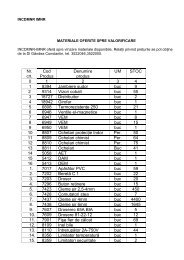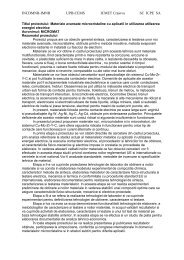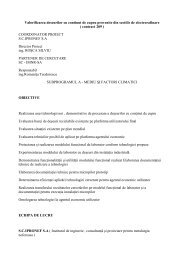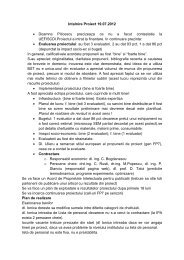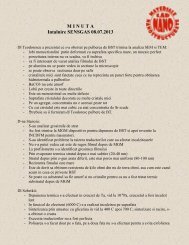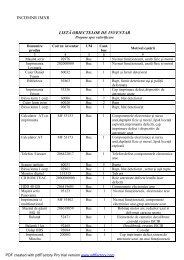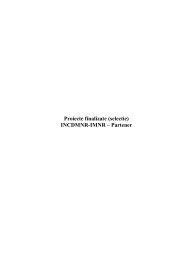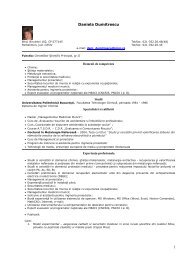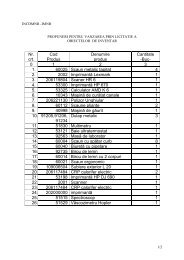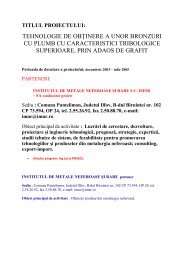Bi2O3-ZnO nanocomposites : a new electrolyte ? - IMNR
Bi2O3-ZnO nanocomposites : a new electrolyte ? - IMNR
Bi2O3-ZnO nanocomposites : a new electrolyte ? - IMNR
- No tags were found...
You also want an ePaper? Increase the reach of your titles
YUMPU automatically turns print PDFs into web optimized ePapers that Google loves.
Bi 2 O 3 -<strong>ZnO</strong> <strong>nanocomposites</strong> : a <strong>new</strong> <strong>electrolyte</strong> ?PREPARATION BY SOLAR PHYSICAL VAPOR DEPOSITION (SPVD)AND NANOSTRUCTURAL STUDYOF PURE AND Bi DOPE <strong>ZnO</strong> NANOPOWDERST.AIT AHCENE, C.MONTY, J.KOUAMA.THOREL, G.PETOT-ERVAS, A.DJEMELROLE PLAYED BY THE GRAINBOUNDARIES ON MATTER TRANSPORT IN NANOMATERIALSTHE BRICK BOUNDARY MODELClaude MONTYWorkshop ECO-NET « FUN-NANOS » Romania 15-22 october 2006 Claude J.MONTY
INTRODUCTIONGeneral Research Topic :‘PREPARATION, CHARACTERISATION, PROPERTIES AND APPLICATIONS OF NANOMATERIALS ’‣ Preparation of nanopowders by Solar Physical Vapor Deposition (SPVD).‣ Preparation of massive nanomaterials and nanostructured coatings.‣ Examples of nanopowders prepared by SPVD :‣ Pure <strong>ZnO</strong>, Zn 1-x In x O, Zn 1-x Sb x O, Zn 1-x Co x O, Zn 1-x Al x O, Zn 1-x Bi x O…‣ TiO 2 , Ti 1-x Fe x O 2 ,‣ CeO 2, , Ce 1-x Gd x O 2 , Zr 1-x Y x O 2 …Workshop ECO-NET « FUN-NANOS » Romania 15-22 october 2006 Claude J.MONTY
Propertiesluminescence : (blue light emission from Zn 1-x Al x O SPVD nanopowders)optical properties : transparency of Zn 1-x Al x O filmsmagnetic properties : (Zn 1-x Co x O ferromagnetic nanophases)chemical reactivity and photoreactivity : TiO 2 , <strong>ZnO</strong>…electrical properties : Zn 1-x Bi x O “varistor effect ”, <strong>electrolyte</strong>s : Ce 1-x Gd x O 2 , Zr 1-x Y x O 2 …Workshop ECO-NET « FUN-NANOS » Romania 15-22 october 2006 Claude J.MONTY
Preparation of nanopowders by SPVDSPVD (Solar Physical Vapor Deposition)NANOSOLSPVD processVaporisation-condensation orsublimation-condensation ina solar reactor.This process is efficient whenthe vapor pressure over thematerial-target is high (<strong>ZnO</strong>,CeO 2, SnO 2, In 2O 3, TiO 2…)NANOSOLVaporisation-condensationsur doigt froid et piégeage sur filtreSOLFACEWorkshop ECO-NET « FUN-NANOS » Romania 15-22 october 2006 Claude J.MONTY
HELIOTRONPreparation of nanopowders by SPVDThe HELIOTRON reactor combinestwo vapor (or smoke) trappingmodes : condensation on a coldfinger and pumping through a filter.HELIOTRONWorkshop ECO-NET « FUN-NANOS » Romania 15-22 october 2006 Claude J.MONTY
Preparation of nanopowders by SPVDHELIOTRONWorkshop ECO-NET « FUN-NANOS » Romania 15-22 october 2006 Claude J.MONTY
Pure <strong>ZnO</strong> nanophases prepared by SPVDPure <strong>ZnO</strong> nanophases prepared byvaporisation-condensation in a solarreactor (SPVD : Solar Physical VaporDeposition process).The nanophases are whiskers ofseveral hundred nm length, 30 à 40nm in diameter, in a tetraedralarrangement.Such nanophases are obtained whenthe pressure in the reactor is of theorder of 70-100Torr.Workshop ECO-NET « FUN-NANOS » Romania 15-22 october 2006 Claude J.MONTY
XRD is a powerful tool• to determine the thermodynamic state of the nanopowders or massive nanomaterials :phase stability (phase diagram), nonstoichiometry, lattice parameters (Bragg law) andtheir correlation with the thermodynamical parameters (composition, T, pO2…)• to determine the average coherency domain size (« grain size ») and the mechanicalstrains and stresses inside the material (Scherrer and Langford relations).3000(101)<strong>ZnO</strong> annealed at 1400°C (48h) under airVC <strong>ZnO</strong> undoped P=35Torr25002000(100)Cps/Sec1500(002)1000(102)(110)(103)(112)500(200)(201)030 35 40 45 50 55 60 65 702 θ (°) C u K αWorkshop ECO-NET « FUN-NANOS » Romania 15-22 october 2006 Claude J.MONTY
XRD is a powerful tool- to determine the thermodynamic state of the nanopowders or massivenanomaterials : phase stability (phase diagram), nonstoichiometry, lattice parameters (Bragglaw) and their correlation with the thermodynamical parameters (composition, T, pO2…)- to determine the average coherency domain size (« grain size ») and themechanical strains and stresses inside the material (Scherrer and Langford relations).1200110010009 0 08 0 0101100002Z n O n a n o p h a s e s7 0 0Intensity6 0 05 0 04 0 03 0 02 0 01022101032122002010041 0 0010 20 30 40 50 60 70 802 Θ [d e g ]Workshop ECO-NET « FUN-NANOS » Romania 15-22 october 2006 Claude J.MONTY
It is the Full Width at Half Maximum which gives access to the coherency domain size(average size of the substructure).To determine FWHM (without monochromator) it is necessary to decompose the XRDpeaks to separate the components related to the wavelengths used and to fit theexperimental profile. A Lorentz function provides a good fit.<strong>ZnO</strong> powder annealed at 1400°C/48H peak(002)Cps/sec2500200015001000Data: Data1_BModel: LorentzChi^2 = 3498.10123R^2 = 0.98713y0 0 ±0xc1 34.49257 ±0.0008w1 0.08254 ±0.00249A1 272.6963 ±7.40991xc2 34.58442 ±0.0014w2 0.05667 ±0.00473A2 80.84941 ±6.35831Intensity /cts/1000900800700600500400300Model : Lorentzy0 174 ±0xc1 34.48579 ±0.00491w1 0.17182 ±0.00709A1 149.20216 ±15.41406xc2 34.57457 ±0.00816w2 0.12785 ±0.02078A2 40.79178 ±14.50628vc (<strong>ZnO</strong> pur, P air= 35Torr)500200100034.0 34.2 34.4 34.6 34.8 35.0 35.22Θ(°) Cu Kα034.0 34.2 34.4 34.6 34.8 35.02Q /deg/Fig.6 : Pure <strong>ZnO</strong> annealed at 1400°C/48h/air –Deconvolution 002 peak into two Lorentz functions,corresponding to two wavelength λ Kα1et λ Kα2ofcupper.Fig.11 : Pure vapo-condensed <strong>ZnO</strong> (SPVD) –The two superposed components of 002 peakare more widened than the one of annealed <strong>ZnO</strong>Workshop ECO-NET « FUN-NANOS » Romania 15-22 october 2006 Claude J.MONTY
To determine FWHM (Full Width at Half Maximum) corresponding to the size effectcoherency domain size, it is necessary to take into account for the ‘’instrumental function’’which is the value FWHM 0(2θ) measured on a reference material with a large grain size.<strong>ZnO</strong> powder annealed at 1400°C/48H peak(002)25000.20Cps/sec200015001000Data: Data1_BModel: LorentzChi^2 = 3498.10123R^2 = 0.98713y0 0 ±0xc1 34.49257 ±0.0008w1 0.08254 ±0.00249A1 272.6963 ±7.40991xc2 34.58442 ±0.0014w2 0.05667 ±0.00473A2 80.84941 ±6.35831FWHM(°)0.150.10<strong>ZnO</strong> annealed 1400°C/48H/airY =0.10128-8.93451 10 -4 X+1.27696 10 -5 X 25000.05034.0 34.2 34.4 34.6 34.8 35.0 35.22Θ(°) Cu KαFig.6 : Pure <strong>ZnO</strong> annealed at 1400°C/48h/air –Deconvolution 002 peak into two Lorentz functions,corresponding to two wavelength λ Kα1et λ Kα2ofcupper.Langford (1986)<strong>ZnO</strong> annealed at 1400°C/48H/airLangfordY =0,0977-8.21023 10 -4 X+1.17081 10 -5 X 20.0020 30 40 50 60 70 80 90 100 1102Θ (°)Workshop ECO-NET « FUN-NANOS » Romania 15-22 october 2006 Claude J.MONTY
Influence of the air pressure in the reactoron the «average « grain size » of pure <strong>ZnO</strong>nanopowders obtained by SPVD.Grain size (nm)50403020VC [undoped <strong>ZnO</strong>]Note : A shape anisotropyappears in this diagram, itcorresponds to the tendency of<strong>ZnO</strong> nanophases to formwhiskers elongated along the[001] direction (c-axis).a1000 20 40 60 80 100 120Air pressure (Torr)(100)(002)(110)xyzcbWorkshop ECO-NET « FUN-NANOS » Romania 15-22 october 2006 Claude J.MONTY
Influence of the air pressure in the reactor on the crystallographic cellof pure <strong>ZnO</strong> nanopowders prepared by SPVD.5.223.275.213.26Parameter "c"5.20Parameter "a"3.255.19VC undoped <strong>ZnO</strong><strong>ZnO</strong> annealed at 1400°C/48h/air<strong>ZnO</strong> JCPDS 75-0576- JCPDS 79-0205- JCPDS 80-0075- JCPDS 36-14515.180 20 40 60 80 100 120Air pressure (Torr)3.24VC undoped <strong>ZnO</strong><strong>ZnO</strong> annealed at 1400°C /48h/air<strong>ZnO</strong> JCPDS 75-0576- JCPDS 79-0205- JCPDS 80-0075- JCPDS 36-14513.230 20 40 60 80 100 120Air pressure (Torr)48.047.9The cristallographic cell iselongated along the c-axiswhen the pressure inside thereactor increases.Volume of the unit cell of <strong>ZnO</strong>47.847.747.647.547.447.347.247.1VC undoped <strong>ZnO</strong><strong>ZnO</strong> annealed at 1400°C/48h/air<strong>ZnO</strong> JCPDS 75-0576- JCPDS 79-0205- JCPDS 80-0075- JCPDS 36-145147.00 20 40 60 80 100 120Air pressure (Torr)Workshop ECO-NET « FUN-NANOS » Romania 15-22 october 2006 Claude J.MONTY
XRD : <strong>ZnO</strong> nanopowders compared to theoretical powdersIntensity1200110010009 0 08 0 07 0 06 0 05 0 04 0 03 0 02 0 01 0 00101Z n O n a n o p h a s e s10000221010310221220120000410 20 30 40 50 60 70 802 Θ [d e g ]Comparing to atheoretical spectrum(CaRine), there is aninversion of the XRDpeaks intensities :the 002 line has notthe maximumintensity, 210 is notthe second highestpeak… This isprobably due to atexture effect.Intensity (% )1000,0,2(34.43,100.0)90802,-1,0(56.61,74.3)701,0,1(36.26,66.4)60502,-1,2(67.97,51.3)401,0,0(31.78,34.5)301,0,3201,0,2(62.88,16.7)(47.55,13.1)2,0,110(69.10,6.8) 0,0,42,0,0(72.59,4.3) 2,0,2(66.39,2.4)(76.98,1.9)2 θ (°)010 15 20 25 30 35 40 45 50 55 60 65 70 75 80Workshop ECO-NET « FUN-NANOS » Romania 15-22 october 2006 Claude J.MONTY
<strong>ZnO</strong> XRD : ’’normal’’ powders compared to theoretical powdersCompared to a theoretical spectrum (CaRine), there is an inversion of the XRD peaks intensities : the 002 linehas not the maximum intensity, 210 is not the second highest peak… This is probably due to a texture effect.4 0 0 03 5 0 0P u r e Z n O p o w d e r a n n e a l e d a t 1 4 0 0 ° C / 4 8 H / a i r3 0 0 02 5 0 0Cps/sec2 0 0 01 5 0 01 0 0 05 0 002 0 3 0 4 0 5 0 6 0 7 0 8 0 9 0 1 0 0 1 1 02 Θ (°) C u K αIntensity (% )1000,0,2(34.43,100.0)90802,-1,0(56.61,74.3)701,0,1(36.26,66.4)60502,-1,2(67.97,51.3)401,0,0(31.78,34.5)301,0,3201,0,2(62.88,16.7)(47.55,13.1)2,0,110(6 9.1 0 ,6.8 ) 0,0,42,0,0(72.59,4.3) 2,0,2(6 6.3 9 ,2.4 )(7 6 .98 ,1 .9 )2 θ (°)010 15 20 25 30 35 40 45 50 55 60 65 70 75 80Workshop ECO-NET « FUN-NANOS » Romania 15-22 october 2006 Claude J.MONTY
<strong>ZnO</strong>-Bi 2 O 3Among the elements added to <strong>ZnO</strong> to obtain controlled properties, Bi is well known.The electrical properties resulting from Bi additions are used in varistors where theintensity-voltage curves (I-V) are the signature of a given composition andmicrostructure.The initial idea was to study the changes of I-V characteristics as a function of thegrain size and to look specially at nanomaterials.Using the expertise resulting from other systems <strong>ZnO</strong>-M a O bprepare Bi doped <strong>ZnO</strong> nanopowders...we have tried toWorkshop ECO-NET « FUN-NANOS » Romania 15-22 october 2006 Claude J.MONTY
<strong>ZnO</strong>-Bi 2 O 3 phase diagram1100(a)(b)110010001000Temperature (°C)900800700<strong>ZnO</strong>(ss)<strong>ZnO</strong>(ss)+liquid<strong>ZnO</strong>(ss)+24Bi 2 O 3 .<strong>ZnO</strong><strong>ZnO</strong>+liqBi 38 <strong>ZnO</strong> 58 +<strong>ZnO</strong>740°liquidγ-Bi 2 O 3 +liqBi 38 <strong>ZnO</strong> 58 +liq753° γγ-Bi 2 O 3 +Bi 38 <strong>ZnO</strong> 58710.α- Bi 2 O 3 + Bi 38 <strong>ZnO</strong> 58900800α+ γ700α6000 1 2 3 4 5 655 60 65 70 75 80 85 90 95 100600mol % Bi 2O 3Workshop ECO-NET « FUN-NANOS » Romania 15-22 october 2006 Claude J.MONTY
(222)ZBO(310) ZBOXRD diagram of (<strong>ZnO</strong>) a(Bi 2O 3) apowder mixturesannealed in air at 700°C5000<strong>ZnO</strong>+ 5% wt Bi 2O 3annealed at 700°C during 17h under air<strong>ZnO</strong>+ 12% wt Bi 2O 3annealed at 700°C during 17h under air<strong>ZnO</strong>+ 20% wt Bi 2O 3annealed at 700°C during 8h under air(101) Z4000Z: <strong>ZnO</strong>ZBO : Bi 38<strong>ZnO</strong> 58Cps/Sec30002000(100) Z(002)Z1000(220) ZBO(321) ZBO024 25 26 27 28 29 30 31 32 33 34 35 36 372 θ (°) CuKαWorkshop ECO-NET « FUN-NANOS » Romania 15-22 october 2006 Claude J.MONTY
Synthesis of the Bi 38<strong>ZnO</strong> 58+δ phase (cubic)Mixing 19 moles Bi 2 O 3 and 1 mole <strong>ZnO</strong>,annealing in air 12h at 700°C and 5h at 730°C2200200018001600(310)(321)New phase Bi 38<strong>ZnO</strong> 58+δ(annealed at 730°C /air)ZnB i 38O 60JCPDS 41-0253α -Bi 2O 3JCPDS 71-2274δ -B i 2O 3JCPDS 77-0374<strong>ZnO</strong> JCPDS 79-0205Cps/sec140012001000800600(222)400200027 28 29 30 31 32 33 34 35 36 372 θ (°) C u KαWorkshop ECO-NET « FUN-NANOS » Romania 15-22 october 2006 Claude J.MONTY
XRD nanopowders obtained by SPVD from (<strong>ZnO</strong>) a(Bi 2O 3) btargetsTwo solid solutions are formed : Zn 1-x Bi x O and β-(Bi 1-y Zn y ) 2 O 31500(110)(103)VC [<strong>ZnO</strong> + 5 % wt Bi 2O 3]VC [<strong>ZnO</strong> + 12 % wt Bi 2O 3]VC [<strong>ZnO</strong> + 20 % wt Bi 2O 3]Zn 1-xBi xO yβ -(Bi 1-xZn x) 2O 3-y<strong>ZnO</strong> JCPDS 80-0075Bi 7.65Zn 0.350 11.83JCPDS 43-04491000Cps/Sec(112)500(203)(421) (213)(402)(200)(201)054 56 58 60 62 64 66 68 702 θ (°) C u K αWorkshop ECO-NET « FUN-NANOS » Romania 15-22 october 2006 Claude J.MONTY
Influence of the target ’s initial composition on the XRD spectraperformed on the SPVD nanopowdersThe Zn 1-xBi xO solid solutionCps/Sec12001000800600400(103)(103) peak is shiftedcompared to pure <strong>ZnO</strong> andis widened when the Bicontent increases.(<strong>ZnO</strong>)+ 5%wt(Bi 2 O 3 )200(<strong>ZnO</strong>)+12%wt(Bi 2 O 3 )062.2 62.4 62.6 62.8 63.0 63.2 63.4 63.62θ(°) CuKα(<strong>ZnO</strong>)+ 20%wt(Bi 2 O 3 )Workshop ECO-NET « FUN-NANOS » Romania 15-22 october 2006 Claude J.MONTY
Zn 1-x Bi x O soilid solutionLattice parameters : When Bi is added to <strong>ZnO</strong>, the hexagonal cell is contracted along the c-axisParameter "c"5.225.215.205.195.185.175.165.15(3)(2)(1)Target Composition (at % Bi)1.84.58VC [Bi doped <strong>ZnO</strong>]<strong>ZnO</strong> annealed at 1400°C/48h/air<strong>ZnO</strong> JCPDS 75-0576- 79-0205- 80-0075- 36-1451VC [<strong>ZnO</strong>] (1) P = 5 Torr,(2) P = 30 Torr,(3) P = 70, 100 TorrParameter "a"3.303.293.283.273.263.253.243.23Target composition (at % Bi)1.84.58VC [Bi doped <strong>ZnO</strong>]<strong>ZnO</strong> annealed at 1400°C/48h/air<strong>ZnO</strong> JCPDS 75-0576- 79-0205- 80-0075- 36-1451VC [<strong>ZnO</strong>] (1) P = 5 Torr,(2) P = 30 Torr,(3) P = 70, 100 Torr5.143.225.133.215.12-2 0 2 4 6 8 10 12 14 16 18 20 22Target composition (wt %Bi 2O 3in <strong>ZnO</strong>)3.20-2 0 2 4 6 8 10 12 14 16 18 20 22Target composition (wt %Bi 2O 3in <strong>ZnO</strong>)48.0Target composition (at % Bi)1.84.58Cell volume of <strong>ZnO</strong>47.947.847.747.647.547.447.347.247.1(3)(2)(1)VC [Bi doped <strong>ZnO</strong>]<strong>ZnO</strong> annealed at 1400°C/48h/air<strong>ZnO</strong> JCPDS 75-0576- 79-0205- 80-0075- 36-1451VC [<strong>ZnO</strong>] (1) P = 5 Torr,(2) P = 30 Torr,(3) P = 70, 100 Torr47.0-2 0 2 4 6 8 10 12 14 16 18 20 22Target composition ( wt % Bi 2O 3in <strong>ZnO</strong>)Workshop ECO-NET « FUN-NANOS » Romania 15-22 october 2006 Claude J.MONTY
5040VC [undoped <strong>ZnO</strong>]55504540Grain size (nm)302010(100)(002)(110)00 20 40 60 80 100 120Grain size (nm)35302520151050(100)(002)(101)0 5 10 15 20 25Air pressure (Torr)Target composition ( wt % Bi 2O 3in <strong>ZnO</strong>)Air pressure influence on the « grainsize » of SPVD <strong>ZnO</strong> nanophases.Influence of the Bi content on the«grain size»of SPVD <strong>ZnO</strong> 1-xBi xOnanophasesWorkshop ECO-NET « FUN-NANOS » Romania 15-22 october 2006 Claude J.MONTY
HRTEM of SPVD Nanopowders<strong>ZnO</strong><strong>ZnO</strong>+5%wtBi 2O 3<strong>ZnO</strong>+10%wtBi 2O 3Zn 1-x Bi x O et β-(Bi 1-x Zn x ) 2 O 3HexagonalTetragonalWorkshop ECO-NET « FUN-NANOS » Romania 15-22 october 2006 Claude J.MONTY
<strong>ZnO</strong>+20%wtBi 2 O 3Zn 1-x Bi x O and β-(Bi 1-x Zn x ) 2 O 3HexagonalTetragonalWorkshop ECO-NET « FUN-NANOS » Romania 15-22 october 2006 Claude J.MONTY
SPVD (Solar Physical Vapor Deposition) (<strong>ZnO</strong>) a (Bi 2 O 3 ) b nanopowders :Average Bi content as a function of the target composition50XPS analysis (for SPVD nanopowder obtained from annealed target at 700°C/air)X-Ray Fluorescence (for SPVD nanopowder obtained from non-annealed target)(<strong>ZnO</strong>) a (Bi 2 O 3 ) bAverage composition of the nanopowders ( wt % Bi O ) 2 34540353025201510500 5 10 15 20 25 30 35 40 45 50Initial composition of the target ( wt % Bi2 O 3 )The XPS or fluorescence analysis ofthe targets and of the SPVDnanopowders shows there is anenrichment of the nanopowders. If ananealing of the initial mixture has beenperformed, the increase is lessimportant : that means a Bi loss duringthe annealing (700°C / air / 8-17h).Workshop ECO-NET « FUN-NANOS » Romania 15-22 october 2006 Claude J.MONTY
Sintered sample ( air 820°C/2h and 1000°C/2h )The used nanopowders (Φ g =35nm) were obtained bySPVD from <strong>ZnO</strong>+15%wtBi 2 O 3 targets.‘’grain size’’ of the sample : 130 nmthe β-phase is now an α-phaseThe sample is nanostructured with two phases : Zn 1-x Bi x O and α-(Bi 1-x Zn x ) 2 O 3+δ )XRDspectrum60005000V C [Z n O + 1 0 w t B i 2O 3] sintered at 1000°C/2h in airV C [Z n O + 1 0 w t B i 2O 3] sintered at 820°C/2h in air<strong>ZnO</strong> 80-0075α -B i 2O 3(71-2274)Zn 1-zBi zO(100)(101)α -(B i 1-xZn x) 2O 3+γ4000(002)Cps/Sec300020001000(111)(120)(012)(121)(200)(210)(130)(112)026 28 30 32 34 36 382θ(°) C u K αWorkshop ECO-NET « FUN-NANOS » Romania 15-22 october 2006 Claude J.MONTY
<strong>ZnO</strong>-Bi 2 O 3 phase diagram1100(a)(b)110010001000Temperature (°C)900800700<strong>ZnO</strong>(ss)<strong>ZnO</strong>(ss)+liquid<strong>ZnO</strong>(ss)+24Bi 2 O 3 .<strong>ZnO</strong><strong>ZnO</strong>+liqBi 38 <strong>ZnO</strong> 58 +<strong>ZnO</strong>740°liquidγ-Bi 2 O 3 +liqBi 38 <strong>ZnO</strong> 58 +liq753°γ-Bi 2 O 3 +Bi 38 <strong>ZnO</strong> 58710900800α+ γ700αα- Bi 2 O 3 + Bi 38 <strong>ZnO</strong> 58γ.6000 1 2 3 4 5 655 60 65 70 75 80 85 90 95 100600mol % Bi 2O 3Workshop ECO-NET « FUN-NANOS » Romania 15-22 october 2006 Claude J.MONTY
Electrical conductivity42δ-Bi 2O 3log σT (S.cm -1 .K)0-2-4-6β-Bi 2O 3Nanos (<strong>ZnO</strong>) 95.2(Bi 2O 3) 4.8Φ g=130nmα-Bi 2O 3α-Bi CeO 2+10% mol Ge 2O 32O 3Zr 0.81Y 0.19O 2Bi 38<strong>ZnO</strong> 58+δNanos (<strong>ZnO</strong>) 98.7(Bi 2O 3) 1.3-88 10 12 14 16 18 20 22 24 26 28 3010 4 /T (1/K)Workshop ECO-NET « FUN-NANOS » Romania 15-22 october 2006 Claude J.MONTY
Ionic conductivity measurementsImpedance spectroscopyR(single ionic crystal)C-Z″( Ω x 10 4 )θ =ωω M10monocristal5630 KHz112 KHzZrO 2+ Y 2O 3(9.5%mol)28 KHz300°Cω M = 1/RCR v00 5 10 15 20Z′( Ω x 10 4 )V(ωt)I(ωt+φ)= R V Z(ω) : résistance = Z’(ω) – du j Z’’(ω) volume = R (monocristal) 1-jθ1+θ 2Workshop ECO-NET « FUN-NANOS » Romania 15-22 october 2006 Claude J.MONTY
R 1C 1R 2C 2Ionic conductivity measurementsImpedance spectroscopy(ionic polycristals)V(ωt)-Z²( Ωx 10 3 )I(ωt+φ 1) = Z 1 (ω) = Z 1 ’(ω) – j Z 1 ’’(ω) 0 1 2 3 4V(ωt)I(ωt+φ 2) = Z 2 (ω) = Z 2 ’(ω) – j Z 2 ’’(ω)θ 1 =ωω M1θ 2 =ωω M22015105450 KHz(ZrO2 + 4 %molY2O3)300°C4.5 KHz0R1R25 Hzω M1 = 1/R 1 C 1 ω M2 = 1/R 2 C 2Z¢( Ωx 10 4 )Workshop ECO-NET « FUN-NANOS » Romania 15-22 october 2006 Claude J.MONTY
-Z²( Ωx 10 3 )2015(ZrO2 + 4 %molY2O3)300°CR VC VR //105450 KHz4.5 KHz5 HzR1 R00 1 2 23 4Z¢(Ωx 10 4 )R ⊥C ⊥C //Workshop ECO-NET « FUN-NANOS » Romania 15-22 october 2006 Claude J.MONTY
Brick Boundary ModelcaδBricks = cubes of size aGrain bondaries, thickness δa = α δσ Vσ //σ Vσσ Vσ VWorkshop ECO-NET « FUN-NANOS » Romania 15-22 october 2006 Claude J.MONTY
Effective bulk conductivityof the i-speciesσ 1 = σ v ΘΘ = α2 +(2α+1)να(α+1)Effective total conductivityof the i-speciesσ 2 = σ vΘ1+ μΘν =μ =σ J //σ vσ vσ JWorkshop ECO-NET « FUN-NANOS » Romania 15-22 october 2006 Claude J.MONTY
« International workshop on Mechanical Properties in Advanced Materials : recent insights »Fuenteherridos –SEVILLE 7-11 june 2006Matter transport in iono-covalent materialsJ i= - (c iD i/ kT) grad η iJ i= - (c iD i/ kT) grad (μ i +q i V)Diffusionnal creep : V=0J i= - (c iD i/ kT) grad μ iη i = μ i +q i V = μ° i+ kT log c i+ q iVApplied electric field :J i= -c iD i[(grad c i / c i ) -(q iE / kT)]constant composition electric stationary currentJ i= (c iD iq iE )/ kT) I i=J iq i= c iD iq i2E / kT = σ iEσ i= c iD iq i2/ kTWorkshop ECO-NET « FUN-NANOS » Romania 15-22 october 2006 Claude J.MONTY
Brick Boundary Model61χ 1 = σ 1/σ v =D 1 /D v543ν= σ sc/σ v = D J / Dv //ν=10 0ν=10 1ν=10 2ν=10 3ν=10 4ν=10 50-1-2log 10χ 12log 10χ 2-3χ 2 = σ 2/σ v = D 2 /D vν=σ sc/σ v =D J // /D vμ=σ b/σ v =D J L /D v10Brick Boundary Model (C.Monty 2002)-1-1 0 1 2 3 4 5 6log 10α-4-5-6log 10αν=10 6 -1 0 1 2 3 4 5 6ν=10 0 μ=10 0ν=10 1 μ=10 1ν=10 2 μ=10 2ν=10 3 μ=10 3ν=10 4 μ=10 4ν=10 5 μ=10 5ν=10 6 μ=10 64χ 2=σ 2/σ v=D 2/D vν=σ sc/σ sv=D J // /D v321μ=s v/s b=D v/D J Lν=10 4 μ=10 4ν=10 4 μ=10 3ν=10 4 μ=10 2ν=10 4 μ=10 1ν=10 4 μ=10 0log 10χ 20-1-2-3-4-1 0 1 2 3 4 5 6log 10αWorkshop ECO-NET « FUN-NANOS » Romania 15-22 october 2006 Claude J.MONTY
ConclusionsThe (<strong>ZnO</strong>) a-(Bi 2O 3) b<strong>nanocomposites</strong> prepared from SPVD nanopowders with 15%wt mol - Bi 2O 3arehighly conducting at 300°C. The conductivity measured is ionic and higher than that of β− Bi 2O 3orgadolinum doped ceria until 700°C.If any electronic conductivity appears at temperatures below 700°C and if (as the mostprobably is) their conductivity is associated to the oxygen ions diffusion, these compounds could be oneof the best <strong>electrolyte</strong> material for SOFC.Prospects- To control the preparation of <strong>nanocomposites</strong> (<strong>ZnO</strong>) 78-(Bi 2O 3) 22[SPVD , Optimisation of the final composition, reproducibility, anisotropic nanostructures (colonnarcoatings)…]- Nanostructural studies of the <strong>nanocomposites</strong>. Thermodynamic stability.- Transport properties (electrical conductivity, oxygen diffusion).- Ageing studies.- Modelling of transport properties (composite effect)Workshop ECO-NET « FUN-NANOS » Romania 15-22 october 2006 Claude J.MONTY




